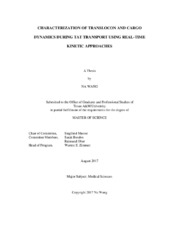| dc.description.abstract | Proteins must be translocated from ribosomes where they are synthesized to different cellular destinations where they perform their functions. Many different protein translocation systems carry out this activity like the human nuclear pore complex and the bacterial Sec and Tat machineries. In Escherichia coli, twin arginine translocation (Tat) system is used to transport fully folded proteins across the bacterial cytoplasmic membrane and the thylakoid membrane in plants without collapsing the ion gradients. A minimal Tat system consists of 3 integral membrane proteins: TatA, TatB and TatC. TatB and TatC form a receptor complex for the signal peptide of substrates. In the presence of a proton motive force and substrate, TatA is recruited to form the conducting channel allowing the mature domain of the substrate to migrate through it. After transport, TatA disassembles from the TatBC complex. Biochemical and biophysical work has provided information about the mechanism of Tat transport, however, the details of the mechanism are poorly understood. Therefore, we want to develop an in vitro transport assay at single vesicle level to characterize the sub-steps of Tat mechanism at the single vesicle level using total internal reflection fluorescence (TIRF) microscopy.
In vitro bulk experiments showed that the transport assay could be conducted at room temperature, which simplifies the assay under microscope by avoiding the temperature-control device. Additionally, ATP could replace NADH to generate PMF, which could maintain a longer membrane potential. 1.5% PVP could replace BSA to avoid background fluorescence. Vesicles could be tethered on the coverslip surface by biotin-streptavidin linkage. Last, the pre-SufI with unnatural amino acid mutation in the signal peptide and cysteine mutation in the mature domain could not be labeled with Azide-Alexa647 and Alexa568 at the same time. In total, these results laid foundation for the in vitro transport assay at the single vesicle level. | en |


